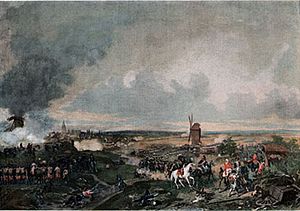Battle of Hondschoote (1793)
| Battle of Hondschoote | |||||||
|---|---|---|---|---|---|---|---|
| Part of the French Revolutionary Wars | |||||||
 Battle of Hondschoote |
|||||||
|
|||||||
| Belligerents | |||||||
|
|
|
||||||
| Commanders and leaders | |||||||
|
|
|
||||||
| Strength | |||||||
| 40,000 | 24,000 | ||||||
| Casualties and losses | |||||||
| 3,000 | 4,000 | ||||||
The Battle of Hondschoote took place during the Flanders Campaign of the Campaign of 1793 in the French Revolutionary Wars. It was fought during operations surrounding the Siege of Dunkirk between 6 and 8 September 1793 at Hondschoote, Nord, France, and resulted in a French victory under General Jean Nicolas Houchard and General Jean-Baptiste Jourdan against the command of Marshal Freytag, part of the Anglo-Hanoverian corps of the Duke of York.
By August 1793, the Coalition Army under command of the Austrian Prince of Coburg had taken Condé, Valenciennes, and Le Cateau in Northern France. The Allies planned to next besiege Cambrai, however the British government ordered the Duke of York's Anglo-Hanoverian corps to instead seize the coastal port of Dunkirk, the possession of which they believed would be a valuable military base and bargaining counter. Its defences, manned by 8,000 men under the command of Joseph Souham, were thought to be in a poor state of repair and vulnerable to capture. York concentrated at Menen and split his command in two forces: 22,000 British troops he led directly to invest the city of Dunkirk, while the 14,500 man covering army of Marshal Freytag consisting of the Hanoverian troops and ten squadrons of British cavalry had to protect his left flank. The Duke of York drove Souham's men back into Dunkirk, taking the Rosendaël suburb on 24 August then digging in to besiege Dunkirk from the east side. The siege looked as though it might be a protracted affair, as York had neither siege artillery nor the manpower to properly surround the city.
...
Wikipedia
